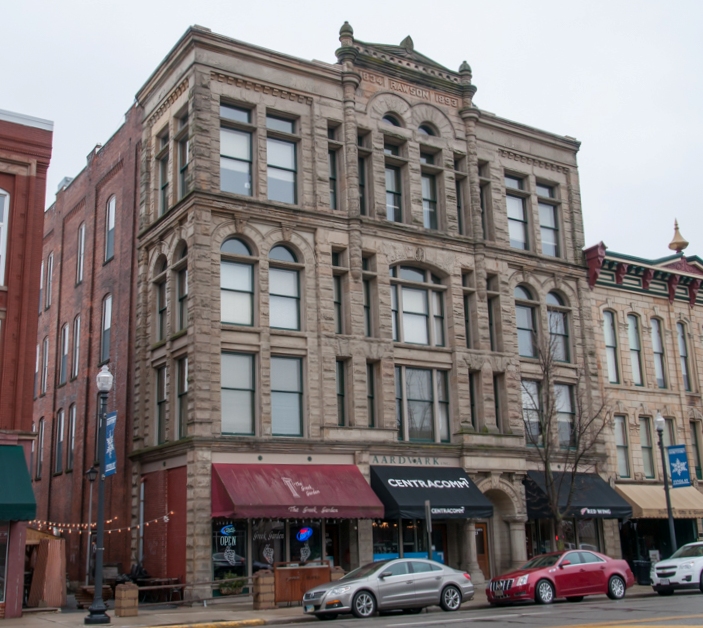Rawson Block Easement
321 S Main St.
Findlay, OH 45840
December of 2004 was an exciting time for Heritage Ohio’s nascent easement program, when it accepted its first easement, taken on the Rawson Block located in downtown Findlay. A lot has changed since we accepted that first easement nearly 14 years ago, including exterior protection as a result of the easement.
Before the IRS adopted new regulations on easements and their donations, only the façade of a building was commonly “donated” in an easement agreement, and that was the case with the Rawson Block. However, our Rawson Block easement also included a loss of development rights, insuring there is never any building “up” on the site. Now, the IRS stipulates that for an owner to realize a charitable contribution (and subsequent federal tax deduction) the entire building envelope must be included under the terms of the easement. The IRS also enacted new regulations to ensure that only legitimate nonprofit organizations such as Heritage Ohio hold easements on historic properties. In fact, the Department of Justice went so far as to bring suit against the Trust for Architectural Easements over its easement acceptance practices.

As is the case with many of our easements, the agreement included stipulations for exterior alterations and stipulations restricting new construction either on the property or above the building (the loss of development rights mentioned earlier).
Working with the Rawson Block owners was a unique experience, too, as the LLC owner of the building comprised more than 50 community members who pooled their money to purchase and rehab a historic landmark in their downtown. And it’s a lesson we still enjoy sharing today: before you die of old age waiting for the rich developer to come riding in on his real estate unicorn to save your buildings, gather your residents together, pool your money, and save your places that matter NOW! It can be done, as the folks in Findlay can attest to.
![]()
What’s Happening on Main Street – April 2019
April 5
-
First Friday: Civic Pride – Delaware
April’s First Friday will feature many community partners who focus on sustainable efforts including Delaware County Health District, Sustainable Delaware, Preservation Parks, Soil and Water Conservation and Kroger! There will be eco-friendly demonstrations, a scavenger hunt, giveaways, and your chance to meet live Ohio Native turtles!
-
First Friday: Art Walk – Kent
Explore special exhibits, enjoy demonstrations, snacks, hands-on activities and more.
-
First Friday: Marietta’s Birthday Party – Marietta

Enjoy cake, celebration, & history! The community will join together to share their love for Marietta, who is turning 231 years old in 2019!
-
First Friday: Spring into Medina – Medina
Grab your friends and head to historic Medina the first Friday of each month for an evening of socializing, dining, shopping, dancing, laughing, and merriment.
-
First Friday: April Showers Bring May Flowers – Middletown
Come to downtown Middletown and celebrate SPRING! We are hoping the April showers stay away so we can stay dry while we explore all our downtown has to offer!
-
First Friday: Open Late Friday – Mount Vernon
Downtown Mount Vernon businesses will offer shopping, sales, refreshments, and prizes as they welcome shoppers to Mount Vernon.
-
First Friday: Once Upon a Princess – Painesville
Stroll throughout the enchanted downtown businesses and merchants to meet our very special princesses. Registration will be at Fairport Dance Academy where you will be able to pick-up your passport. Meet all the princesses for a chance to win a special prize.
-
First Friday: Easter Egg Hunt – Tipp City

Head to downtown Tipp City for an Easter Egg Hunt with FREE bunny photos at the Library! Kids can stroll around the downtown collecting candy and eggs in participating businesses and you can get your Spring Easter photo taken with our cute bunny as well.
-
First Friday: Superheroes Unite! – Wadsworth
All ages are invited to pull out their best superhero disguises and head to downtown Wadsworth for this fun event!
April 6
-
Putt Around Downtown – Kent
Enjoy miniature golf in downtown Kent! Each putt putt hole will be uniquely designed by 18 individual business. Ticket holders will check in at the Venice Cafe and receive a commemorative golf ball, scorecard and pencil, ticket for raffle prize drawings, and a drink ticket. Play at your leisure from 1 to 4pm, do some shopping, have lunch and drinks along the way, then join us for a drink and raffle prize drawings at the 19th Hole (Venice Cafe).
-
Spring Shop Hop – Tipp City
Spring is in the air so it’s time to get a spring in your step and hop through downtown Tipp City’s shops! Grab your check in cards at any participating downtown business to get started. Once you fill your card you can leave them at any participating business for a chance to win!
-
Easter Egg Drop – Wadsworth
Enjoy this fun family event and win prizes during this annual event.
April 8
-
Cash Mob Monday – Marietta
Cash Mobs are the perfect way to shop local, have fun, and meet new people in our community all at the same time!
April 12
-
2019 Medina Beer Festival – Medina

Join Main Street Medina for the 2019 Medina Beer Fest. The event will be hosted by Williams on the Lake, and will feature over 30 craft beers, food, entertainment, raffles, beer swag, InFocus Photo Booth, and loads of fun.
-
Trivia Night – Van Wert
Gather your four smartest friends, colleagues, and classmates for Main Street Van Wert Trivia Night.
April 13
-
Chocolate Walk – Chardon
You won’t want to miss Chardon’s second Annual Chocolate Walk! Shop, sample, and see all that Chardon has to offer! Hop from participating restaurants to businesses to shops for sweet treats and special offers. Ticket price includes a treat at each stop, a 2019 custom event tote, and a special map/shopping pass for the day. Grab your friends and have some fun!
April 18
-
Annual Downtown Celebration – Marietta
Join Marietta Main Street at The Adelphia Music Hall t0 reflect on 2018 and highlight accomplishments of our downtown businesses, community leaders, organizations and more! Mix & mingle while enjoying appetizers, a cash bar, and live music.
-
Third Thursday: Blooming Artist Stroll – Tiffin
Celebrate Spring in downtown Tiffin! Make your way up Washington Street exploring all Downtown Tiffin has to offer. “Blooming Artist Stroll” features artists and musicians in downtown businesses. Win door prizes while enjoying one-of-a-kind art! Free & fun for everyone!
April 19
-
Kent American Roots Music Festival – Kent
Enjoy a free evening of music with over 20 acts at over 20 venues in Downtown Kent for the 2nd annual Kent American Roots Music Festival.
April 20
-
Earth Day 2 Miler – Chardon
This is a unique race opportunity that breaks the norms of standard races. The Earth Day 2 Miler is a chance to get everyone out for a race while reducing the waste created by common road races.
April 25
-
Revitalization Series Workshop: Promotion – Wadsworth
Join Heritage Ohio in Wadsworth on for the 2nd Revitalization Series Workshop of 2019. The focus of this workshop will be on promotions. Though Main Street programs do many of the critical tasks through design, economic vitality, and organization, the promotions committee is, in general, responsible for activating the downtown through events. Events are what everyone knows Main Streets do, it is one of the highly visible aspects of what we do and can sometimes be the only thing that many in our communities know about us.
Get ready for a day packed with tools to help you succeed in this area. Find out how partnerships can enhance your events, learn how to create unique experiences, tackle social media to improve marketing efforts, tell your story through video, and create the one thing Main Street can’t survive without, a sustainable volunteer culture.
April 26
-
Downtown Pub Crawl – Mount Vernon
Enjoy a fun, adults-only night out on the town! Tickets are $20 per person and include a complimentary pub crawl bottle opener, exclusive drink specials from participating businesses, live music and entry into giveaways at each location which includes gift cards, t-shirts and more.
-
Downtown Troy Cruise-In – Troy

Join Troy Main Street for an evening full of amazing vehicles, games, and fun for all ages.
April 27
-
Clean Up Kent: Spring Edition – Kent
Time for spring cleaning in the City of Kent! Come to the Destination Kent CVB/Visitor Centre to pick up supplies and choose a spot on the map for your group to work. Enjoy a cup of coffee and a donut (on us — while they last) then head out to Clean Up Kent! Trash bags, brooms, dustpans, and rubber gloves provided. Thank you for helping us keep Kent beautiful.
-
Clean Sweep – Marietta
This day of volunteerism requires all hands on deck to support beautification efforts downtown, including Harmar Village. Many hands make light work, and we need as much help as we can muster from local groups, residents, and visitors alike!
-
Downtown Spring Cleanup – Portsmouth
Main Street Portsmouth is get things ready for spring planting and the many guests that will visit with TOSRV and warmer weather, but need your help to make it happen. Help keep the community clean and show your pride in the community.
-
Vermilion in Bloom Gardeners’ Fair – Vermilion
The 15th Annual Vermilion in Bloom Gardener’s Fair will bring the sights and smells of spring to Sailorway Middle School. Shop for flowers and plants from local growers, unique planters, garden art, fairy gardens, one-of-a-kind original art, soaps and lotions and more!
National Register of Historic Places Registration Form – Question 11
This is easily completed and needs no further explanation.
- Form Prepared By
name/title: __________________________________________________________
organization: ________________________________________________________
street & number: _____________________________________________________
city or town: _________________________ state: ____________ zip code:___________
e-mail________________________________
telephone:_________________________
date:_____________________________
CDBG funding for Downtown Revitalization
Wednesday, April 10th – 1:00 pm-2:00 pm
The Office of Community Development will administer a restructured Downtown Revitalization Program in PY 2019. Funds will now be awarded on an open-cycle schedule through application to the Target of Opportunity Program. This session will explain the new program structure, funding parameters, and application requirements. Eligible applicants are restricted to Community Development Program recipients. Cities and villages are encouraged to apply through their counties of jurisdiction.
Speaker
Mary Oakley
Mary Richards Oakley has been employed by the Ohio Development Services Agency’s Community Services Division since 1998. Mary serves as the Community Investments Manager for the Office of Community Development. In this capacity, Mary is responsible for oversight of more than $60 million in Community Development Block Grant (CDBG), Ohio Housing Trust Fund, Appalachian Regional Commission, and Brownfield Revolving Loan funds annually. Programs under her jurisdiction include: Community Development, Critical Infrastructure, and Neighborhood Revitalization; Economic Development and Revolving Loan Fund; Residential Public Infrastructure; and Target of Opportunity and Downtown Revitalization. Mary earned a Bachelor of Science degree in Economics and German from Centre College in Danville, Kentucky and graduated from The Ohio State University’s Masters Program in City and Regional Planning.

Become a member of Heritage Ohio today and enjoy a full year of monthly webinars and many other benefits.
![]()
National Register of Historic Places Registration Form – Question 10
schedule for March 11th when information has been collected from the SHIPO office.
10. Geographical Data
Acreage of Property _______________
Use either the UTM system or latitude/longitude coordinates
Latitude/Longitude Coordinates
Datum if other than WGS84:__________
(enter coordinates to 6 decimal places)
- Latitude: Longitude:
- Latitude: Longitude:
- Latitude: Longitude:
- Latitude: Longitude:
Or
UTM References
Datum (indicated on USGS map):
NAD 1927 or NAD 1983
- Zone: Easting: Northing:
- Zone: Easting: Northing:
- Zone: Easting: Northing:
- Zone: Easting : Northing:
Verbal Boundary Description (Describe the boundaries of the property.)
Boundary Justification (Explain why the boundaries were selected.)
2019 Annual Awards
What is the awards nomination process?
To nominate a a person, building, or project, complete a nomination form and attach supporting documents and high-resolution photos. If your documents or photos are large files, please email them to fquinn@heritageohio.org with the name of the nomination in the title of the email. To view a detailed description of the awards categories, view the 2019 Awards List.
All nominations must be received by July 1, 2019. Nominations that do not follow the formatting provided in the form, and incomplete entries will NOT be accepted.
Not sure if your nomination fits a category? Contact us at 614-258-6200 or fquinn@heritageohio.org and we will be happy to discuss the nomination with you.
Where will the awards ceremony be held?
The 2019 Heritage Ohio Annual Awards Ceremony will take place in Newark on October 22, 2019. Tickets to the conference will go on sale in June of 2019.
Award Categories
Main Street Awards
- Best Main Street Committee Project or Event
- Main Street Business of the Year
- Main Street Executive Director of the Year
- Main Street Volunteer of the Year
- Spirit of Main Street
Complete a nomination for a Main Street Award
Rehabilitation Project Awards
- Best Commercial Rehabilitation
- Best Public Building Rehabilitation
- Best Public-Private Partnership
- Best Residential Rehabilitation
- Best Upper Floor Residential Rehabilitation
Complete a nomination for a Rehabilitation Project Award
Place Awards
- Historic Farmstead of the Year
- Historic Theater of the Year
Complete a nomination for a Place Award
Design Awards
- Best Downtown Placemaking
- Best Commercial Building Facade Improvement
- Best Commercial Building Interior Improvement
Complete a nomination for a Design Award
Individual Awards
- Outstanding Leader in Revitalization
- Preservation Hero
- Young Preservationist of the Year
DIY Market Analysis: Free Data to Explore and Demonstrate Downtown Market Opportunities Webinar
Wednesday, March 6th – 1:00 pm-2:00 pm
Are you interested in demonstrating the economic opportunities of doing business in your downtown?
More and more data sources are available online today from both public and private organizations. The data can produce facts and figures of interest to investors, lenders and business operators. This webinar will explore a sample of data sources and how they can be used in both a comprehensive market analysis and in just-in-time research to answer questions that arise.
The discussion will look at data that can be utilized in the Downtown and Business District Market Analysis toolbox. This resource has been developed and updated by Extension in Wisconsin, Ohio, and Minnesota. The toolbox provides a structure for conducting community–led studies involving a local volunteer study group.
Webinar participants will leave with various sources that can provide new insights on study area and trade area dynamics.
Time will be reserved at the end for a “show and tell” of other data sites that we have missed. So if you have a valuable source of data useful in understanding your district, community, or trade area, drop it in the chat box during the webinar.
And yes, to amend the rivalry between Ohio and Wisconsin, Extension educators and downtown professionals will have each other’s company as we learn and share together.
This webinar is a benefit of Heritage Ohio membership, to become a member click HERE
Heritage Ohio Members, register for the webinar click HERE
Speakers:

Bill Ryan
Bill Ryan works for the University of Wisconsin-Madison/Extension and is a statewide specialist in downtown and tourism business development. He provides research and educational programs throughout the state with city, chamber, and other economic development leaders interested in filling empty space and repurposing their downtowns with new uses for buildings. Bill co-authored an on-line downtown market analysis toolbox which is used nationwide to guide community – led market studies. Prior to Extension, Bill was employed in financial planning and hotel development in Boston.

Jon Wolfrath
Jon Wolfrath is a graduate student in the Masters of Urban and Regional Planning program at the University of Wisconsin – Madison. He is focusing his studies on economic development, transportation, and housing. He also works for the University of Wisconsin – Madison/Extension as a Community Business Development Analyst and has assisted in market analysis research and resource development.

Danielle Steinhauser
Danielle Steinhauser, CMSM works for CT Consultants, a municipal engineering firm in OH, KY, PA & WV. She works with municipalities and downtown organizations to plan projects and find funding resources. Her work is diverse, allowing her to assist communities with everything from market analyses and strategic planning to streetscapes to water and storm water lines and treatment facilities. Danielle has worked on several dozen Downtown Plans for communities across Ohio and Pennsylvania, including recommendations and implementation strategies in all of Main Street’s Four Points. Prior to her work in consulting, Danielle was a Main Street Manager in Toledo, Ohio.
This webinar is a benefit of Heritage Ohio membership, to become a member click HERE
Heritage Ohio Members, register for the webinar click HERE
![]()
National Register of Historic Places Registration Form – Question 9
- Major Bibliographical References
Bibliography (Cite the books, articles, and other sources used in preparing this form.)
Federal Works Agency, Final Report on the WPA Program, 1935-43, Washington, DC: U.S. Government Printing Office, 1946, pp. 7-10. (2) Ibid. at p. iii (“Letter of Transmittal”).
Donald S. Howard, The WPA and Federal Relief Policy, New York: Russell Sage Foundation, 1943, p. 126.
‘William Wilson Cooke’ The Journal of Negro Education, (February 1942): n.p.
“African American Architects: A Biographical Dictionary, 1865-1945”
edited by Dreck Spurlock Wilson, 2004, pp. 108-111 and pp. 325-327
Kielisch, Erik (March 4, 2005), “Plato’s Influence Remains on Campus: Works of Swallow Robin’s Architect Comes to the Archives”, The Echo: The Taylor University’s School Newspaper, Upland, IN, 92 (20), pp. 1–2
The Filson Historical Society Archive – https://www.filsonhistorical.org/archive/news_v1n1_plato.html – The Filson News Magazine Volume 1, Number 1
The Plato Family Papers, 1924-1967, are available at the Filson Historical Society in Louisville, KY.
National Park Service (2010-07-09). “National Register Information System”. National Register of Historic Places. National Park Service.
Samuel M. Plato, 1882-1957: A collection of accomplishments, by Neher, Leslie I. and Betty Drook Shutt, 1997
In Black and white : a guide to magazine articles, newspaper articles, and books concerning more than 15,000 Black individuals and groups, by Spradling, Mary Mace
“Samuel M. Plato,” Black History News & Notes, 1992, no. 47-54, p. 4
Hall, Clyde W. One Hundred Years of Educating at Savannah State College, 1890-1990. East Peoria, III.: Versa Press, 1991, p.14
East Peoria, III.: Versa Press, 1991. “William Wilson Cooke.” The Christian Educator, p.45
The Daily Standard, Celina, Ohio – January 16th, 1940, p.2
___________________________________________________________________________
Previous documentation on file (NPS):
____ preliminary determination of individual listing (36 CFR 67) has been requested
____ previously listed in the National Register
____ previously determined eligible by the National Register
____ designated a National Historic Landmark
____ recorded by Historic American Buildings Survey #____________
____ recorded by Historic American Engineering Record # __________
____ recorded by Historic American Landscape Survey # ___________
Primary location of additional data:
____ State Historic Preservation Office
____ Other State agency
____ Federal agency
____ Local government
____ University
____ Other
Name of repository: _____________________________________
Historic Resources Survey Number (if assigned): ________________
National Register of Historic Places Registration Form – Question 8c.
Narrative Statement of Significance (Provide at least one paragraph for each area of significance.)
This means we need a paragraph on each of these topics:
Ethnic Heritage
Black (African American)
Politics / Government
Social History
Art
Politics / Government
The Coldwater Post Office was part of the New Public Works Programs, created within Franklin D. Roosevelt’s New Deal. Specifically, the Post Office was created under the umbrella of the Works Progress Administration (WPA) (1935) (renamed Work Projects Administration, 1939)
President Roosevelt created the WPA on May 6, 1935 with Executive Order No. 7034, under authority of the Emergency Relief Appropriation Act of 1935. Harry Hopkins was the first administrator of the WPA, serving from July 1935 through December 1938.
The WPA was the largest and most diverse of the New Deal public works programs. It was created to alleviate the mass unemployment of the Great Depression and by the time it was terminated in 1943, the WPA had put 8.5 million Americans back to work.
The majority of WPA projects built infrastructure, such as bridges, airports, schools, parks, and water lines. In addition, the Federal Project Number One programs undertook theater, music, and visual arts projects, while other service programs supported historic preservation, library collections, and social science research. The WPA also employed women in sewing rooms and school classrooms and cafeterias, and in the later run-up to war it improved many military facilities.
The WPA employed people directly. A typical project began at the local level, with city and county governments assessing their needs and unemployment numbers. Proposals were thensent to a WPA state office for vetting before being forwarded to headquarters in Washington, D.C. and, finally, to the president for final approval. Projects could be rejected anywhere along this three-step process, and were not imposed on local communities by the Federal government. Normally, localities had to provide about 12-25% to trigger federal funding of WPA projects.
We know that by 1935, the Works Progress Administration (WPA) was employing approximately 350,000 African Americans annually, about 15% of its total workforce. In 1934, the Public Works Administration (PWA) inserted a clause in all government construction contracts that established a quota for the hiring of black laborers based on the 1930 labor census and as a consequence a significant number of blacks received skilled employment on PWA projects. The Coldwater Post Office is a clear representation of this positive bias.
In 1939, after a federal government reorganization, the Works Progress Administration was renamed the “Work Projects Administration” and was placed under the newly created Federal Works Agency.
There is a copy of the speech given at the cornerstone ceremonies for this post office on June 10, 1940. It details much of what has been outlined above with respect to Coldwater specifically. Below are some relievent extracts from that document.
Under authority of the Emergency Construction Program, Act approved August 25, 1937, an allotment of $75,000 was made to include the cost of a site, erection and the administration of this project.
The building was designed by the Office of the Supervising Architect, Public Buildings Administration, Federal Works Agency.
Ethnic Heritage and Social History
On January 22, 1940, the Federal Works Agency awarded the construction contract to Mr. Samuel Plato of Fort Thomas, Kentucky, in the amount of $49,350, the building to be completed within 300 calendar days from date of receipt of notice to proceed.
The post office is one of the oldest institutions in our American. This service had its beginnings in the earliest Colonial days and in the three hundred years of its existence, it has been on of the most important influences in the development and progress of our country. It has been an indispensable aid to our commerce and to our business and social life in all periods of American history.
The Post Office Department is the one department that is older than the Government itself, that is, than our Government under our Constitution, it having been established by the Continental Congress before the adoption of the Constitution. It is the largest single business institution in the world and it is the only branch of our Government that reaches and is in intimate contact with all the people. Many of our citizens have no other contact with our Federal Government but through the post office.
Because of the fact that the postal service vitally touches the lives of all our citizens and affects the business of the nation, it must be maintained at a high degree of efficiency, must function with clock-work regularity and yet must be intensely human in its management. There is no other business, public or private, that to sue ha great extent renders personal service. Everything that is done in the postal service, all of the work that is performed, is personal service to individuals.
This new post office which is being constructed here will be the home of an establishment owned and managed by the people, an establishment in which they will place their most sacred and personal confidence and an establishment which will facilitate the transmission of their business, their correspondence, their papers and their merchandise. It will also be an institution that safeguards the people’s earnings and transits their money wherever desired.
I want to place emphasis upon the fact that it is the main purpose of the Postmaster General to render the best possible service to every one, rich or poor, and without regard to race, creed or color.
Black (African American)
In March 1907. William Wilson Cooke sat for and passed the three day federal civil service examination given at a site in Boston. He was not allowed to take the examination in the District of Columbia because of his race. He was told to report to work for the U.S. Treasury Department Supervising Architect’s Office. Unaware of his race, his arrival at the Treasury Department building in downtown Washington, D.C., caused quite a stir. His probationary appointment was as an architectural draftsman, making him the first African American to serve in a professional capacity in the Supervising Architect’s Office. He successfully served his six-month probationary term and on September 21 was permanently appointed an architectural draftsman. In 1909 Cooke was transferred to Field Operations, where he supervised the construction of federal courthouses and post offices in Pennsylvania, Ohio, Illinois and West Virginia. Cooke remained with the Supervising Architect’s Office until 1918, a relatively long time, eleven years. He was promoted and transferred to the War Department. From 1921 he was in private practice in Indiana. He obtained his state architect license on October 14, 1929, becoming the first of his race to be licensed to practice architecture in the state of Indiana. The Wall Street crash in 1929 put him out of business. In 1931 Cooke returned to the Supervising Architect’s Office as a construction engineer. He designed and supervised the construction of small-town post offices in Ohio (one of which was the Coldwater Post Office), Illinois, Missouri, Michigan, Wisconsin and Minnesota. He retired from federal service in 1942.
One of the African American contractors chosen by W.W. Cooke, was Samuel Plato.
The architecture of Samuel Plato is significant for many different reasons. The most prominent reason could be the success achieved by an African-American Architect in the early Twentieth Century. Samuel Plato turned to designing his own buildings and promoting himself after being turned away from most Caucasian-owned design and contracting companies. During the construction of his buildings, it was an unusual twist of fate that the very contractors which turned Plato down came to him seeking a job.
Samuel Plato was born in Waugh, Alabama, in 1882. His father was trained by a former slave and carpenter named Samuel Carter (Arts Indiana 24). Plato’s father had raised him to learn the craft of carpentry. To pay for college and train fare to the University in Louisville, Plato carved out wooden washboards, which he sold for $.25 each before heading off to college. Samuel initially wanted to study in the field of law, but soon his all-consuming interest was geared toward architecture and carpentry. While in college, he did much work repairing campus buildings to earn tuition and board. After graduating, Plato relocated to Marion, presumably to find work in the gas boom economy. Increasing numbers of people were flooding the area at this time; thus, houses and other public structures needed to be built. In his first few years in the Marion area, however, no contractor would hire him due to his race. His very first job was refinishing the stairs and trim in an eight room house. The owner, so impressed by his top-quality work, recommended him for two more jobs at other residences. From this point on, Plato had very little trouble finding work. Eventually, in the early 1920’s, Plato returned to Louisville where he continued his career as a productive, high-quality architect and craftsman. Plato was the first African American to be selected for the designing and contracting of federal buildings in the United States. In 1957, Samuel Plato died at home in Louisville.
The buildings designed and contracted by Plato are of great historical value due to their high quality of craftsmanship, authentic use of a multitude of styles, and their ability to defy age. One trademark evident in the buildings Plato designed are the simple yet beautiful windows, along with their placement. All Platonian buildings have finely crafted windows, and most have retained some, if not all of the original glass and casings. Plato learned the art of carpentry from his father, and his talent was evident in the construction of the cabinets, doors, and windows in his buildings. Plato’s styles range from bungalow, to Mediterranean, to Greek-revival, all are related by the superior craftsmanship and evident carpentry.
He was the first African American to receive a government contract to build a post office. He designed thirty-eight post offices in his career as well as churches, schools, banks, theaters, and housing.
He completed his education and began his career at a time when segregation and racism were major obstacles for African Americans who sought to pursue professional careers such as architecture. When Plato graduated from State University Normal School in Louisville in 1902 and completed his mail-order program in architecture with International Correspondence Schools, he became part of a small group of pioneering African American architects who made their mark early in the Twentieth Century.
Like other pioneers, Plato struggled against racism, helping pave the way for those who followed in his footsteps. During his early years in Marion, Indiana, he was successful in his fight to open up the building trade unions to African American workers. He was the first African American to be awarded a contract to build a post office, and he was one of only a few African American contractors to build federal government defense housing projects during World War II. Plato was successful because of his persistent efforts and because his reputation for quality and integrity could not be ignored.
Plato designed and/or built a wide variety of buildings, including Greek Revival and Craftsman-style houses, elegant mansions, post offices, banks, churches, schools, office buildings, theaters and government housing projects. Eight of his buildings are listed on the National Register of Historic Places, including the Broadway Temple A.M.E. Zion Church in Louisville, Kentucky and the Pythian Temple in Columbus, Ohio.
Art
National Register of Historic Places Registration Form – Question 8a.
8. Statement of Significance
Applicable National Register Criteria
(Mark “x” in one or more boxes for the criteria qualifying the property for National Register listing.)
It has been clear to us from the beginning that Coldwater Post Office is most significant because of it’s association with African American Architects, Plato and Cooke. This criteria informs all our answers to the following questions
| x | A. | Property is associated with events that have made a significant contribution to the broad patterns of our history |
| B. | Property is associated with the lives of persons significant in our past. | |
| C. | Property embodies the distinctive characteristics of a type, period, or method of construction or represents the work of a master, or possesses high artistic values, or represents a significant and distinguishable entity whose components lack individual distinction | |
| D. | Property has yielded, or is likely to yield, information important in prehistory or history |
Criteria Considerations – these don’t apply to us
(Mark “x” in all the boxes that apply.)
- Owned by a religious institution or used for religious purposes
- Removed from its original location
- A birthplace or grave
- A cemetery
- A reconstructed building, object, or structure
- A commemorative property
- Less than 50 years old or achieving significance within the past 50 years
Areas of Significance
(Enter categories from instructions.)
_____Ethnic Heritage_______
_____Black (African American)_
_____Politics / Government__
_____Social History____
_____Art___________
___________________
___________________
Period of Significance
____1940 – 1949_______
Significant Dates
___The duration of the New Deal_
Significant Person
(Complete only if Criterion B is marked above.)
___________________
___________________
___________________
Cultural Affiliation
___________________
___________________
___________________
Architect/Builder
___William Wilson Cooke__
___Samuel Plato________
___________________
For Statement of Significance and Narrative Statement – please see the next blog post


